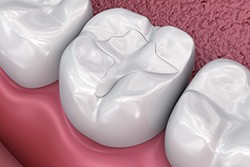Tooth-Colored Fillings Syracuse
Conservative Tooth Repairs for Minor Cavities

If you have a nail-sized hole in your wall, you don’t take out the entire wall or cut out a huge section. You stick to a more conservative, less invasive repair method. The same concept applies to dentistry. Sometimes, with the exception of a tiny cavity, a tooth is still largely useable. In this case, we don’t need to go to great lengths to repair it. A tooth-colored filling is enough to restore the tooth to its full appearance and function. Before your small issue turns into a more serious one, give us a call to schedule an appointment to get a tooth-colored filling.
Why Choose Creative Dental Concepts for Tooth-Colored Fillings?
- Patients of All Ages Treated
- Flexible Financing Available
- Compassionate, Experienced Dental Team
What Are Tooth-Colored Fillings?

While more severe problems are treated with a crown or other restoration, a little cavity doesn’t require covering the entire tooth. As a result, a small bit of composite resin, which consists of a fine plastic and porcelain mixture, can be inserted into the hole and complete the tooth again.
Unlike amalgam or metal fillings used in the past, these fillings can be shaded the same color as the surrounding tooth, which means this material blends in.
The Process of Getting a Tooth-Colored Filling

Once the cavity is identified, Dr. Craybas will numb that area of your mouth with a local anesthetic. Afterward, he will remove the damaged portion of the tooth, creating a tiny hole in the enamel. Then, he will select a shade that most closely matches your tooth and mix the composite resin, which starts as a putty-like substance. He will put the resin in the tooth and try to shape it as naturally as he can, and then he will shine a curing light, solidifying the resin. Finally, after making some refinements, like making the surface smooth, he will check to make sure your bite feels comfortable.
The Benefits of Tooth-Colored Fillings

Although amalgam fillings tend to last a little bit longer purely because of the material’s durability, this tooth-colored option comes with many significant advantages. Namely, heat and cold can expand and contract metal, potentially leading to sensitivity and even additional breakage. Composite resin doesn’t react to temperature and bonds directly with the enamel, which means you should have a strong protective seal. Also, because of the matched color, your composite fillings shouldn’t be easily noticeable, hiding your repairs and helping with your confidence. Even if more intensive repairs become necessary in the future, preserving your natural tooth structure for as long as possible is well worthwhile.
